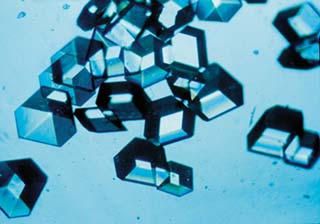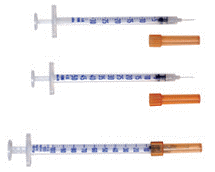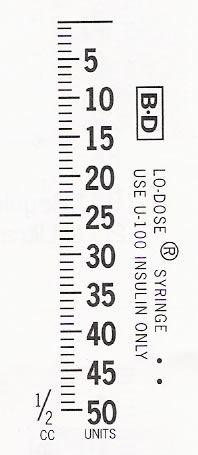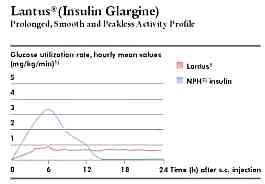
Insulin

Insulin
Insulin is a substance produced by the pancreas that is used by the body to break down sugars in the blood. While in a healthy adult it occurs naturally in the body, it can be manufactured from synthetic materials or harvested and refined from animal sources so that it can be given to patients who have a shortage of insulin in their bodies.
Insulin is primarily used in the treatment of diabetes. Someone who has diabetes has too much sugar in their blood; to maintain lower blood sugar levels that are in the normal range, diabetics are often given insulin.
The correct dosing of insulin is very important:
Giving a patient too little insulin does not adequately lower blood sugar so that they are still left with too much sugar in the blood; too much sugar the the blood can cause damage to blood vessels, leading to blindness, kidney failure, severe problems with limbs (especially the feet), stroke and heart disease.
Giving a patient too much insulin can lower blood sugar too much and lead to dangerously low levels of sugar in the blood, which can cause seizures and coma, because the brain depends primarily on glucose (sugar) in the blood for fuel. Even before a person's blood sugar level drops low enough to cause seizure or coma, low blood sugar levels can lead to mood swings, impaired mental function, blurred vision, nausea and vomiting, heart palipitations and shakiness.
Insulin is given by injection because it cannot be taken orally - the stomach will break it down so that is is no longer effective in breaking down blood sugar.
Insulin should always be dosed using special insulin syringes marked with insulin units. Common insulin U-100 syringes can hold 100 units; there are also Lo-dose syringes, which are syringes that can hold a total of 30 units or 50 units. (See photo below.)

The above picture shows the syringes themselves but they are so small that they can be hard to read, so often we flatten out the measurement on the side of the syringes, so that each syringe label looks something like the pictures below:
 |
 |
 |
Lo-Dose insulin syringe for measuring up to 50 units Each mark is 1 unit apart. |
Insulin syringe for measuring up to 100 units Each mark is 2 units apart. |
Insulin syringe for measuring up to 100 units Each mark is 2 units apart. Even numbers are marked on the scale on the right and odd numbers are marked on the scale on the left. |
Insulin is measured in International Units (units); most insulin is U-100, which means that 100 units of insulin are equal to 1 mL.
There are two different ways in which insulin can be classified.
Origin: Is the insulin derived from animal sources, such as beef and/or pork, or human sources in a laboratory?
This can be important, as a drug order may specify the origin of the prescribed insulin, because some patients respond more effectively to insulin from one source rather than another.
Action: How quickly does the insulin take effect?
There are now four basic action speeds of insulin:
Rapid Action: The most rapidly-acting insulins are relatively new; of the two brands available, one has been around for 5 years and the other, 10 years (by comparison, the rapid action insulins were developed in the th 1920's). These insulins begin to work in 5-10 minutes, peak in 1-1.5 hours, and end in 3-5 hours. These rapid-acting insulins are taken at the beginning of a meal to counteract the rise in blood sugar due to eating, or they are used to lower blood sugar levels quickly when they are too high.
The names lispro (brand name Humalog) and insulin aspart (brand name Novolog) both indicate rapid-action insulins.
Fast Action: Fast-acting insulin begins to work in about half an hour, peak in 2.5 to 5 hours, and then end in about 8 hours. Fast action insulins are often taken about a half hour before a meal, to counteract the rise in blood sugar that follows.
The names Regular and Semilente (the term used by the Humulin brand) both indicate fast-action insulins. To see a visual illustration of the difference in action between rapid and fast-acting insulins, see the charts below which show insulin levels over time in hours after an insulin injection:
 |
 |
Intermediate Action: The intermediate-acting insulins begin to work in 1.5 to 2.5 hours, peak in 4 to 15 hours, and then end in 16 to 24 hours.
The names NPH and Lente (the term used by the Humulin brand) both indicate intermediate action insulins.
Long Action: The long-acting insulins begin to work in about 4 hours, peak in about 10 to 30 hours, and end in about 36 hours.
The name Ultralente (the term used by the Humulin brand) indicates a long action insulin. The name glargine (brand name Lantus) also indicates a relatively newly developed long-acting insulin, but it has a more even action which keeps insulin levels steady throughout the day, so it does not peak in the way that the other insulins do. (See chart below.) Glargine/Lantus cannot be mixed with other insulins.

Sometimes two different action speeds of insulin may be ordered to be given at the same time. When this happens, both insulins are drawn up into the same syringe and given simultaneously so that the patient does not have to be stuck with a syringe more than once. When this happens, the more rapidly acting insulin is always drawn up into the syringe first, because this avoids any possibility of the more rapidly acting insulins being contaminated with the more slowly acting kinds. It also establishes a habitual order in the dosing process that helps to eliminate the mistake which occurs when the person measuring the insulin confuses the dose of the fast-acting insulin with the dose of the more slowly-acting insulin.
Rapid and fast acting insulins are always clear, and intermediate or long-acting insulins are always cloudy (except glargine/Lantus, which is clear) , because the longer acting insulins are actually made up of a suspension - if you look closely at insulin labels, you can see that the longer-acting insulins are always described as suspensions.